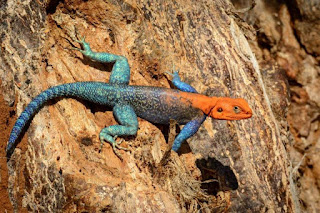
Agama is a species of lizard. There are more than 60 species of agama that are native to Africa, Europe and Asia. Agamas is the dominant species of lizard in Africa. In the past, agamas lived in the forests of Africa. As the forests began to disappear, Agama managed to adapt to living in open spaces. Most types of agamas live in mountains, rocky steppes, and arid areas. Certain types of agama have adapted to life in both rural and urban areas. Some people keep agamas as pets because of their beautiful body color. Agamas are not listed as endangered animals.
While most agamas are green and brown, dominant males show off by rapidly turning their bodies blue and their heads bright red or yellow.
Agama can reach 15.7 inches in length.
Most agamas live in small groups with the dominant male ruling over several females and sub-males.
Head, neck and thighs of agamas are covered with scales.
While sunning themselves each morning, the dominant male will claim the most elevated spot, with subordinates in lower areas.
Agamas live in groups that are composed of one dominant male, couple subordinate males and large number of females.
Agamas hunt by vision and prefer to wait for an insect to come by.
Dominance in the group is accomplished through fights. Dominant male is called “cock”. This male enjoys certain privileges: he mates with females and gets the best place for rest.
Agamas sticky tongues help them hold onto prey.
Color of the agama’s body depends on its gender and its position within the group. All females are green or brown. Subordinate males have a body that is brown, gray, red, blue, or yellow in color. Dominant male is brightly colored. It has blue body with red (or yellow) head.
According to species, agamas live in forest, in bush, among rocks and on crags, but where their habitat has been cleared, or simply invaded by humans, some species also adapt to life in villages and compounds, for example inside the thatch of huts and other sheltering crevices.
Because of the impressive coloration of the body of the dominant male, these lizards are sometimes called “rainbow lizards”.
Agamas are diurnal, active during the day.
Agama primarily feeds on insects. It lays motionless and waits for the insects to appear. It catches the insects by using its long and sticky tongue. Agama usually eats ants, crickets, caterpillars, worms and spiders.
They can tolerate higher temperatures than most reptiles, but when temperatures approach 38 °C (100 °F) they generally shelter in the shade.
People enjoy having agamas in their neighborhood because they eliminate all the pests from their houses and yards.
Males frequently threaten each other by nodding, weaving, and displaying their brightest colours to establish dominance.
Agama also eats seeds, berries, fruits and eggs of other lizards and birds.
Though not formally polygamous, dominant males commonly accommodate several females at a time in their territory.
Agama has well developed sense of vision, which is used both for hunting of the prey and for avoiding the predators.
Females occasionally initiate courtship by offering their hindquarters to the male and provoking him to catch her.
Main predators of agamas are snakes.
Their jaws are very powerful, and older males commonly have damaged tails as souvenirs of past combat.
Mating season depends on the weather. It takes place after rainy season that will lead to increase in the insect population. Increased amount of available food is essential for females to become ready to lay eggs.
Agamas are mainly insectivorous, hunting prey by sight and snatching it opportunistically.
Female releases between 2 and 20 eggs from June to September. She digs 2-inches deep hole in the moist and sandy ground where eggs will be hidden until the time of hatching.
The female lays her eggs in a hole she digs with her snout and claws.
Depending on the species, eggs will hatch after incubation period that lasts between 1.5 and 4.5 months.
Females reach sexual maturity at age fourteen to eighteen months, males at two years.
Agama can survive for a long period of time in the wild. Average lifespan of agama is between 25 and 28 years.
Agama Lizard FAQs: Unveiling the Colorful World of the African Jewel
Agama lizards, with their vibrant displays and fascinating behaviors, are captivating creatures native to Africa and Madagascar. Here are some FAQs to quench your curiosity about these remarkable reptiles:
1. What are agama lizards?
Agama lizards are a diverse group of lizards belonging to the family Agamidae. Over 400 species exist, ranging in size from a mere few inches to over three feet long. They are known for their:
- Distinctive dewlaps: These colorful flaps of skin under their throats play a vital role in communication, display, and territorial defense.
- Spiny bodies: Many agama species have rough, spiny skin that provides camouflage and protection from predators.
- Exceptional eyesight: Their well-developed vision allows them to spot prey from a distance and navigate their environment effectively.
2. Where do agama lizards live?
Agama lizards inhabit a variety of habitats across Africa and Madagascar, including:
- Savannas and grasslands: The most common habitat for many agama species.
- Rocky outcrops: Some species prefer rocky environments for basking and hiding.
- Forests: Certain agama lizards thrive in the dappled sunlight of wooded areas.
- Deserts: A few hardy species have adapted to survive in arid desert environments.
3. What do agama lizards eat?
Agama lizards are primarily insectivores, feeding on a variety of insects like ants, grasshoppers, beetles, and termites. Some larger species may also consume small mammals, reptiles, and even fruit or flowers.
4. Are agama lizards social creatures?
Social behavior varies among agama species. Some are solitary, while others live in loose social groups with established dominance hierarchies. Males often display their dewlaps and engage in head-bobbing rituals to establish dominance and attract mates.
5. How do agama lizards reproduce?
Agama lizards are oviparous, meaning they lay eggs. Females typically lay clutches of several to two dozen eggs in burrows or under rocks. The eggs incubate for several weeks before hatching into miniature replicas of their parents.
6. What are some interesting facts about agama lizards?
- Color-changing abilities: Some agama species, like the blue-headed agama, can rapidly change the color of their bodies to regulate body temperature, communicate, and camouflage themselves.
- Head-bobbing displays: Males of many agama species perform elaborate head-bobbing rituals to attract mates and intimidate rivals.
- Third eyelid: Agama lizards possess a transparent eyelid, called a nictitating membrane, that helps protect their eyes from dust and debris.
- Expert climbers: With sharp claws and a flexible body, agama lizards are adept at climbing rocks, trees, and other structures.
7. Are agama lizards endangered?
The conservation status of agama lizards varies depending on the species. While some are common and widespread, others face threats like habitat loss, climate change, and the illegal pet trade. Conservation efforts are crucial to protect these fascinating creatures.
8. Can agama lizards be kept as pets?
Agama lizards can be kept as pets, but they require specialized care. They need a spacious enclosure with proper lighting, temperature control, and hiding places. Research the specific needs of the chosen agama species to ensure you can provide them with a healthy and enriching environment. It’s important to note that some countries and regions have restrictions on keeping agama lizards as pets.
9. Where can I learn more about agama lizards?
- Reptile rescue organizations or sanctuaries that care for agama lizards.
- Online resources dedicated to reptiles and herpetology.
- Books and scientific articles on agama lizards and their ecology.
Agama lizards, with their vibrant colors, unique adaptations, and diverse behaviors, are a captivating part of the African and Malagasy ecosystems. By appreciating their fascinating world, we can contribute to their conservation and ensure these remarkable reptiles continue to thrive for generations to come.









